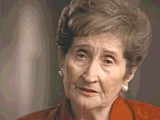You searched for: ������������������������������������������������cxfk69���page
<< Previous | Displaying results 61-70 of 177 for "������������������������������������������������cxfk69���page" | Next >>
-
Illustrated page of a child's diary written in a Swiss refugee camp
PhotoIllustrated page of a child's diary written in a Swiss refugee camp. The diary entry describes how they crossed the border into Switzerland. The text reads, "We came out of the woods and into a clearing: we had to be as quiet as possible because we were so close to the border. Oh! I almost forgot! Before we came out of the woods, they made us stand still for a quarter of an hour while they went to explore the area and to cut through the fence. Fortunately, shortly thereafter, we began to walk again. We saw…
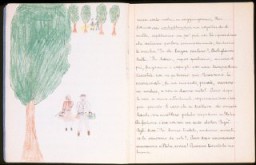
-
Beifeld album page showing houses used as officers quarters
ArtifactIn a drawing dated April 14, 1942, Beifeld shows houses in Csobanka (Szentendre district), Hungary, where the Hungarian military officers assigned to the labor service company were quartered before their departure for the Ukraine. [Photograph #57949]
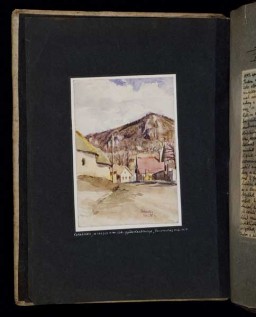
-
Beifeld album page with watercolors titled "Sports weeks" and "Quiet Don"
Artifact(top) "Watercolor entitled 'Sports weeks in Uryv, September 1942' in which a Russian tank attacks a Hungarian unit in Uryv."; (bottom) "Watercolor entitled 'Quiet Don: a detailed map of the Don River area' featuring images of dead soldiers, horses and spilled blood on a map of the Don River." [Photograph #58060]
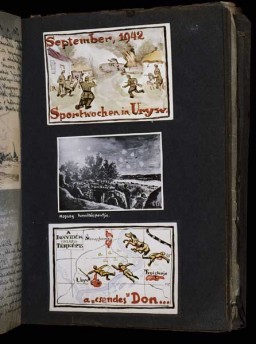
-
Beifeld album page about events of August 28, 1942
Artifact(Top) A drawing dated October 1942 depicting the events of August 28 when Beifeld was wounded near the front lines. His caption reads: "I get wounded and manage to get away from the dangerous bend in the [Don] river]." (Bottom left) Skull of a Soviet soldier with the caption 'Keep Smiling.' (Bottom right) Map entitled 'Dangerous Curve' depicting the bend in the Don River where the Soviet army was threatening to break through. [Photograph # 58061]

-
Beifeld album page outlining the labor service's roles in the war effort
ArtifactA page of drawings illustrating the contribution of Jewish Labor Servicemen to the war effort. At the top: "The different platoons work hard at the battle front and in the no man's land [between the armies]. They actively participate in the fighting. They carry ammunition to the Hungarian soldiers." In the middle: "They defuse land mines. They bury the dead, including those that had been left unburied from the winter campaign. They carry soldiers wounded on the front lines to safety." At the bottom: "For…
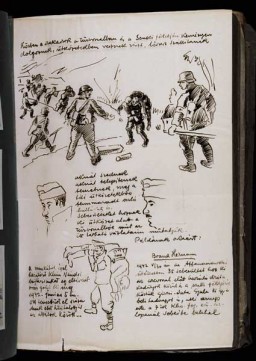
-
Page from Earl G. Harrison's diary entry describing postwar Linz
DocumentPage from Earl G. Harrison's notebook, recording his impressions of Linz, Austria, while on a tour of displaced persons camps in 1945.

-
Leopold Page describes meeting German industrialist Oskar Schindler
Oral HistoryLeopold was a teacher in Krakow, Poland, when World War II began in 1939. While serving in the Polish army, he was captured by Germans. Leopold escaped from a prisoner-of-war transport. Soon after, he met the German industrialist Oskar Schindler. The two became friends. Leopold was forced to live in the Krakow ghetto. He later worked in Schindler's factory in Bruennlitz. He and the other Jews who worked there were treated relatively well and protected from the Nazis. After the war, Leopold moved to the…

-
Leopold Page describes the liquidation of the Krakow ghetto and escaping from the ghetto
Oral HistoryLeopold was a teacher in Krakow, Poland, when World War II began in 1939. While serving in the Polish army, he was captured by Germans. Leopold escaped from a prisoner-of-war transport. Soon after, he met the German industrialist Oskar Schindler. The two became friends. Leopold was forced to live in the Krakow ghetto. He later worked in Schindler's factory in Bruennlitz. He and the other Jews who worked there were treated relatively well and protected from the Nazis. After the war, Leopold moved to the…
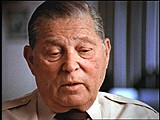
-
Ludmilla Page describes conditions in Oskar Schindler's munitions factory in Brünnlitz
Oral HistoryLudmilla was born to an assimilated Jewish family in Kishinev, Romania. She and her mother, a physician, were living in Poland when the Germans invaded on September 1, 1939. They were taken to Krakow. Ludmilla was forced to live in the Krakow ghetto; her mother was sent to the Warsaw ghetto. Ludmilla worked in a factory at the Plaszow labor camp for a businessman who was a friend of the German industrialist Oskar Schindler. In October 1944, Schindler attempted to save some Jewish workers by relocating them…
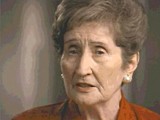
-
Ludmilla Page describes leaving Auschwitz and arriving at the Bruennlitz munitions factory in the Sudetenland
Oral HistoryLudmilla was born to an assimilated Jewish family in Kishinev, Romania. She and her mother, a physician, were living in Poland when the Germans invaded on September 1, 1939. They were taken to Krakow. Ludmilla was forced to live in the Krakow ghetto; her mother was sent to the Warsaw ghetto. Ludmilla worked in a factory at the Plaszow labor camp for a businessman who was a friend of the German industrialist Oskar Schindler. In October 1944, Schindler attempted to save some Jewish workers by relocating them…
